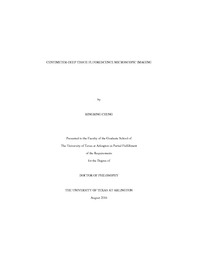| dc.description.abstract | Fluorescence microscopic imaging in centimeter-deep tissue has been highly sought-after for many years because much interesting in vivo micro-information—such as microcirculation, tumor angiogenesis, and cancer metastasis—may deeply locate in tissue. However, it is very challenging because of strong tissue light scattering. This includes: how to confine the fluorescence emission into a small volume to achieve high spatial resolution; how to increase fluorescence emission efficiency to compensate the signal attenuation caused by small emission volume and tissue scattering/absorption; and how to reduce background fluorescence noise and exclusively differentiate signal photons from background photons to increase signal-to-noise ratio (SNR) and sensitivity.
Ultrasonic scattering is two to three orders of magnitude less than light scattering in opaque biological tissue. Therefore, light focusing has been replaced by ultrasonic focusing to achieve high spatial resolution in deep tissue. In addition, high intensity focused ultrasound (HIFU) can noninvasively heat a small region deep within the body (hundreds of microns in lateral). If one can develop a contrast agent whose fluorescence emission is sensitive to this HIFU-induced temperature change and a sensitive imaging system which can detect the ultrasound-controlled photons that have been scattered many times, centimeter-deep tissue fluorescence microscopic imaging can be achievable. This study is focused on developing a fundamentally different imaging technology: ultrasound-switchable fluorescence (USF), including the contrast agent development and the imaging system development. Basically, the USF contrast agent developed in this work is thermosensitive and its fluorescence emission has a switch-like relationship with temperature. Its fluorescence emission can be switched on or off by a focused ultrasound beam generated from a HIFU transducer within its focal volume. Then the diffused USF photons propagate out and are detected by a sensitive USF imaging system.
First, the excellent USF imaging contrast agents were developed by using the environment-sensitive fluorophores and thermosensitive polymers. We started investigating environment-sensitive fluorophores from visible light range up to near infrared (NIR) range since only NIR light can penetrate centimeter-deep in opaque biological tissues. Two basic thermosensitive polymers and their co-polymers were used, including: poly (N-isopropylacrylamide) (PNIPAM) and pluronic. Both linear polymer and nanoparticle based USF contrast agents were explored. Second, a sensitive frequency domain (FD) USF imaging system and an effective signal identification algorithm were developed. The lock-in amplifier adopted in the FD-USF imaging system and the correlation algorithm significantly improved the SNR and detection sensitivity. Third, the feasibility of USF imaging in centimeter-deep tissue with high resolution was demonstrated in both tissue-mimicking phantoms and ex vivo biological tissues. Multi-color high-resolution USF imaging in centimeter-deep tissue with high SNR and picomole sensitivity were also achieved. Fourth, the feasibility of in vivo USF imaging was demonstrated in living mice by using different types of USF contrast agents via both intravenous and local injections.
In summary, the results provided in this work demonstrated for the first time the feasibility of centimeter-deep tissue fluorescence microscopic imaging with high SNR and picomole sensitivity via USF in tissue-mimicking phantoms, porcine muscle tissues, ex vivo mouse organs (liver and spleen), and in vivo mice. Multiplex USF imaging was also achieved, which is useful to simultaneously image multiple targets and observe their interactions. This work opens the door for future studies of center-deep tissue fluorescence microscopic imaging. | |

